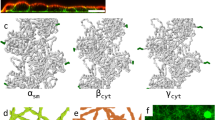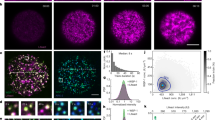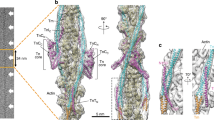Abstract
Actin networks or gels are a major structural component of the cytoplasm in most eukaryotic cells, especially those exhibiting motility1,2. Cell-free extracts from a variety of cell types, including sea urchin eggs3 and Xenopus oocytes4, have been successfully used to examine the regulation of actin gelation and contraction. Although it has been shown that actin gel contraction is myosin-dependent (for review, see ref. 1), nothing is known of the role of myosin phosphorylation in this process. Indeed, much of the evidence suggesting that actomyosin-dependent movement in nonmuscle cells is regulated by myosin phosphorylation is provided by experiments showing that phosphorylation affects actin-activated ATPase activity5,6. Here we report that the rate of actin gel contraction is increased, and several additional gels form and contract, in extracts from Xenopus laevis eggs prepared in conditions that promote protein phosphorylation. Since, in these conditions the 18,000-molecular weight (MW) light chain of myosin is the major phosphorylated component of the contracted gels, these results demonstrate a direct relationship between myosin phosphorylation and actin gel contraction. Evidence is also presented demonstrating that the recurrent waves of gelation and contraction occur in the absence of fluctuations in free-Ca2+ or pH.
This is a preview of subscription content, access via your institution
Access options
Subscribe to this journal
Receive 51 print issues and online access
$199.00 per year
only $3.90 per issue
Buy this article
- Purchase on Springer Link
- Instant access to full article PDF
Prices may be subject to local taxes which are calculated during checkout
Similar content being viewed by others
References
Taylor, D. L. & Condeelis, J. S. Int. Rev. Cytol. 56, 57–144 (1978).
Stossel, T. P. Phil. Trans. Roy. Soc. B299, 275–289 (1982).
Kane, R. E. J. Cell Biol. 86, 803–809 (1980).
Clark, T. G. & Merriam, R. W. J. Cell Biol. 77, 427–438 (1978).
Adelstein, R. S. & Eisenberg, E. A. Rev. Biochem. 49, 921–956 (1980).
Kendrick-Jones, J. & Scholey, J. M. J. Muscle Res. Cell Mot. 2, 347–372 (1981).
Laemmli, U. K. Nature 227, 680–685 (1970).
Meeusen, R. L. & Cande, W. Z. J. Cell Biol. 82, 57–65 (1979).
Cassidy, P., Hoar, P. E. & Kerrick, W. G. L. J. biol. Chem. 254, 11148–11153 (1979).
Tsien, R. Y. & Rink, T. J. Biochim. biophys. Acta 599, 623–638 (1980).
Gorman, A. L. F. & Thomas, M. V. J. Physiol., Lond. 275, 357–376 (1978).
Steinhardt, R., Zucker, R. & Schatten, G. Devl Biol. 58, 185–196 (1977).
Condeelis, J. S. & Taylor, D. L. J. Cell Biol. 74, 901–927 (1977).
Hinke, J. A. M. in Glass Electrodes for pH and other Cations, (ed. Eisenman, G.) 467–477 (Dekker, New York, 1967).
Adelstein, R. S. & Klee, C. B. J. biol. Chem. 256, 7501–7509 (1981).
Cande, W. Z., Tooth, P. J. & Kendrick-Jones, J. J. Cell. Biol. 97, 1062–1071 (1983).
Adelstein, R. S., Pato, M. D., Sellers, J. R., de Lanerolle, P. & Conti, M. A. Cold Spring Harb. Symp. quant. Biol. 46, 921–928 (1981).
Walsh, M. P., Bridenbaugh, R., Hartshorne, D. J. & Kerrick, W. G. L. J. biol. Chem. 257, 5987–5990 (1982).
Wallach, D., Davis, P., Bechtel, P., Willingham, M. & Pastan, I. Adv. Cyclic Nucleotides Res. 9, 371–379 (1978).
Imhof, B. A. et al. Proc. natn. Acad. Sci. U.S.A. 77, 3264–3268 (1980).
Hara, K., Tydeman, R. & Kirschner, M. Proc. natn. Acad. Sci. U.S.A. 77, 462–466 (1980).
Meeusen, R. L., Bennet, J. & Cande, W. Z. J. Cell Biol. 86, 858–865 (1980).
Jeffery, W. R. & Meier, S. Devl Biol. 96, 125–143 (1983).
Trotter, J. A. & Adelstein, R. S. J. biol. Chem. 254, 8781–8785 (1979).
Author information
Authors and Affiliations
Rights and permissions
About this article
Cite this article
Ezzell, R., Brothers, A. & Cande, W. Phosphorylation-dependent contraction of actomyosin gels from amphibian eggs. Nature 306, 620–622 (1983). https://doi.org/10.1038/306620a0
Received:
Accepted:
Issue Date:
DOI: https://doi.org/10.1038/306620a0
This article is cited by
-
Size-dependent transition from steady contraction to waves in actomyosin networks with turnover
Nature Physics (2024)
-
Ca2+-ionophore-induced microvilli and cortical contractions inXenopus eggs. Evidence for involvement of actomyosin
Wilhelm Roux's Archives of Developmental Biology (1985)
Comments
By submitting a comment you agree to abide by our Terms and Community Guidelines. If you find something abusive or that does not comply with our terms or guidelines please flag it as inappropriate.



